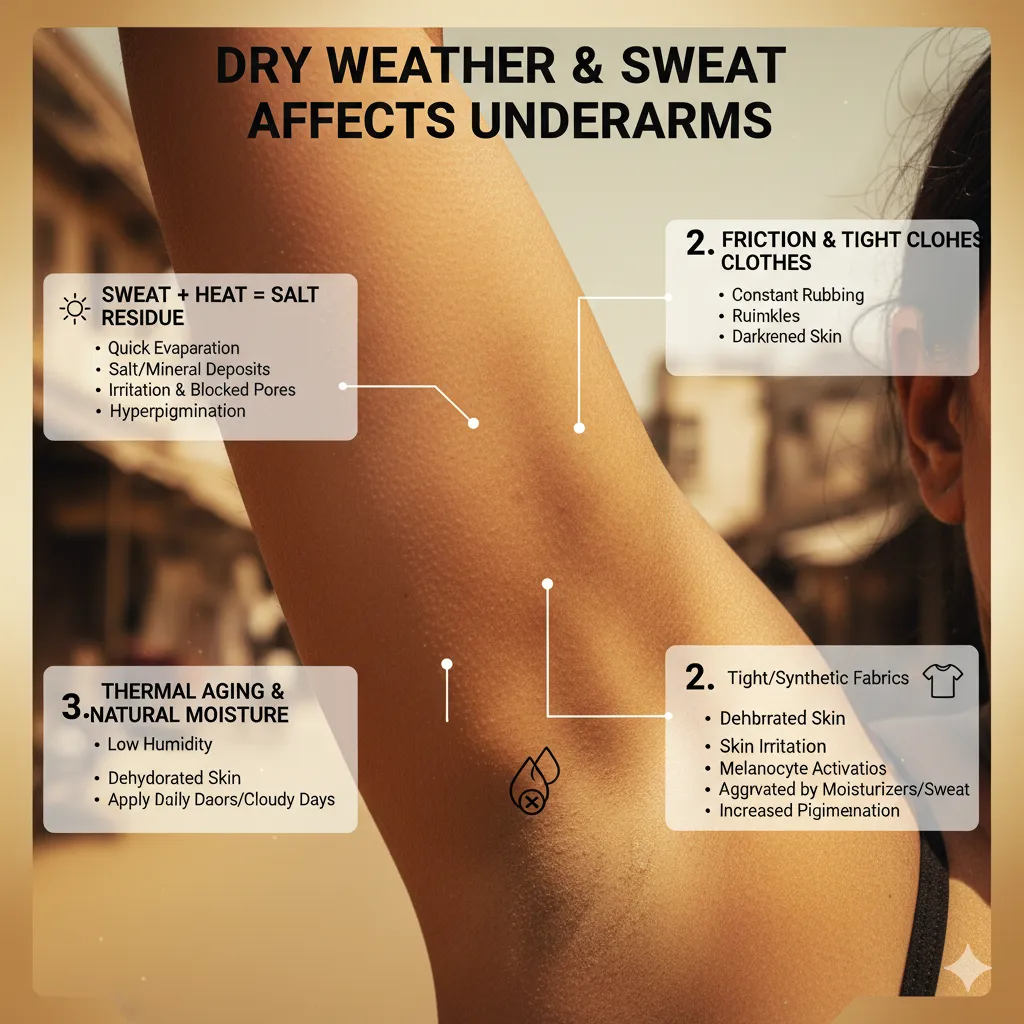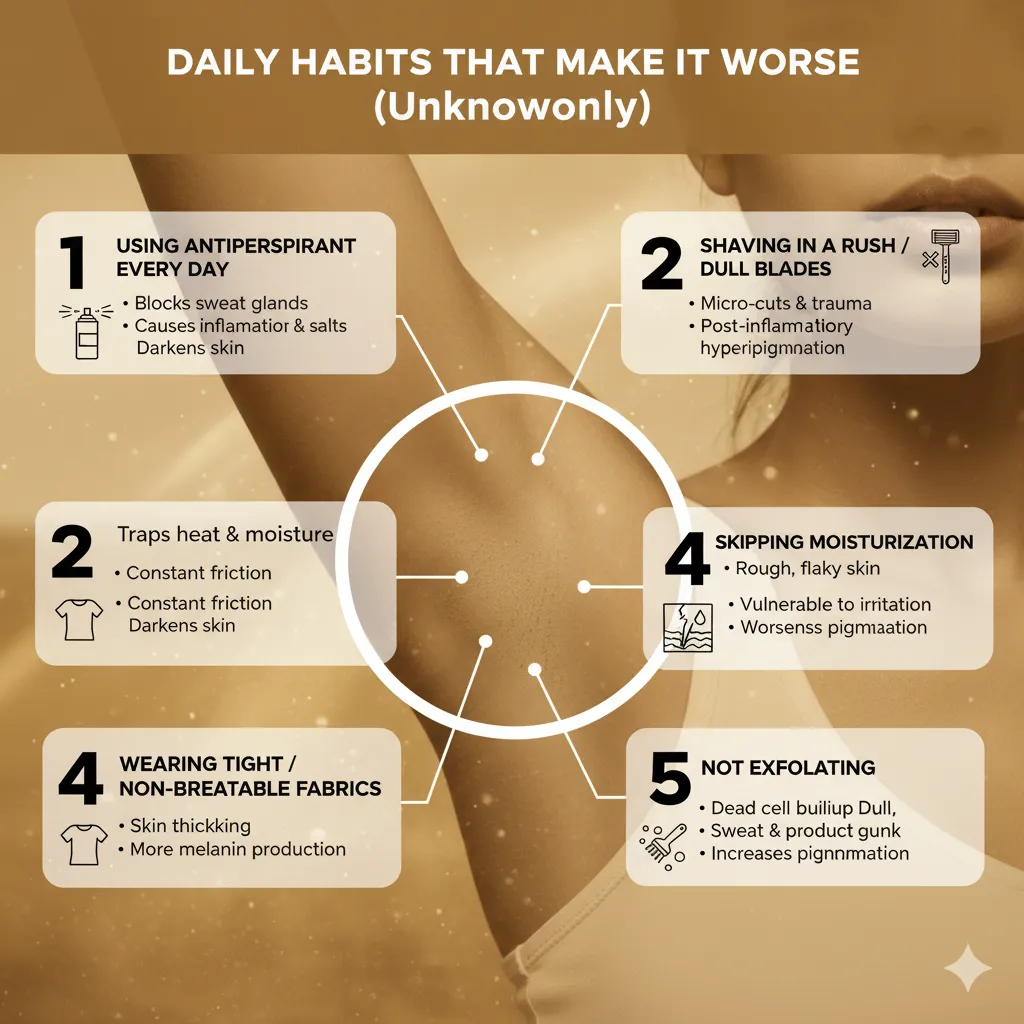Table of Contents
Raipur’s dry heat may sound just like a relief against those pesky coastal humidity situations, but for the skin, particularly in a far more delicate area like the underarms, dry spells are a torment all their own.
Many live silently with underarm pigmentation in Chhattisgarh’s capital without being aware of how much the local climate plays in its aggravation.
Raipur can have an environment with many triggers that can worsen underarm darkness, from atop heat-against-the-sun UV rays to friction from clothes and even intense sweating, even with perceived low humidity.
Yet, the indication is good: it can be handled and reversed in several cases with proper treatment.
Here, we will delve into the science of why underarm pigmentation happens in dry heat areas such as Raipur, why sweat and friction make it worse, and the skincare and lifestyle modifications that can aid its prevention and healing process.
How Dry Weather and Sweat Affect Underarms
Gone are the days when summer temperatures rose above 45 °C in Raipur, conjuring images of humidity levels falling below 25%. At first glance, this appears as if the perfect setting to sit in tranquility, free from the clutches of sweat. But dry zones have a completely different set of skin problems.
1. Sweat + Heat = Trapped Salt Residue
Sweat is a vehicle for temperature regulation in the body, even in dry climates. But with such quickly evaporating moisture, salts, and minerals in sweat get deposited into the creases in the underarms. This irritates, blocks pores, and ultimately ends in hyperpigmentation if not washed away correctly.

2. Friction due to Tight or Synthetic Clothes
In a dry setting, tight clothes shield from dirt and exposure to the sun. Underarm skin, however, gets irritated over time with constant rubbing of clothes, especially synthetic fabrics. Irritation prompts melanocytes to activate, and active melanocytes darken the skin.
3. Absence of Natural Moisture
Low atmospheric humidity means less moisture is available in the air. The skin in your underarms, already under stress due to friction and other factors like deodorants, becomes dehydrated. This dry and irritated skin responds aggravatingly to moisturizers, sweat, products, and movement—thereby piling on to the problems associated with pigmentation.
Underarm Pigmentation: Why It’s Worse in Dry Climates
Let’s break down the science behind pigmentation in the underarm region and how Raipur’s weather makes it worse.
Common Causes of Underarm Darkness:
Cause | Explanation |
Friction | Constant rubbing of the arms or clothes increases melanin production |
Sweat residue | Salts and toxins trapped in folds irritate the skin |
Shaving/Waxing | Frequent hair removal can lead to repeated trauma and darkness |
Deodorants with alcohol | Harsh chemicals inflame the skin, especially in dry zones |
Hormonal changes | PCOS or insulin resistance can affect pigmentation levels |
Specific Climatic Stressors in Raipur:
Climatic Element | Impact on Underarms |
High UV index | Triggers tanning and oxidative stress in exposed areas |
Low humidity | Dehydrates skin and makes it more prone to irritation |
Dust and pollution | Settles in skin folds and clogs pores |
Heat rash from synthetic fabrics | Causes irritation and long-term darkness |
Daily Habits That Make It Worse (Unknowingly)
The underarms are among the most delicate areas of your skin, with thinner, more sensitive layers and constant exposure to friction, sweat, and product build-up. Without daily care and often due to well-intentioned but misguided habits, pigmentation can worsen over time.
Here’s how common everyday actions may be silently triggering or aggravating underarm darkening, especially in a climate like Raipur’s:
1. Using Antiperspirant Every Day
Antiperspirants work by blocking sweat glands with aluminum-based compounds. While this may reduce wetness, it also traps toxins and salts in the skin folds, especially when used in hot, dry climates. Over time, this buildup can clog pores, cause inflammation, and trigger melanin production, resulting in darker underarms.
2. Shaving in a Rush or With Dull Blades
Dry shaving or using dull blades causes micro-cuts, friction burns, and trauma to the underarm skin. Over time, this repeated irritation leads to post-inflammatory hyperpigmentation (PIH), dark spots, or uneven tone in the underarm region.
3. Wearing Tight or Non-Breathable Fabrics
Fabrics like nylon, polyester, or rayon trap heat and moisture while creating constant friction with your skin. This not only causes chafing and irritation but also prompts the skin to protect itself by thickening and producing more melanin.
4. Skipping Moisturization
Just like your face or hands, the underarm area needs daily hydration. In dry climates like Raipur’s, skin loses moisture rapidly, and unmoisturized underarms become rough, flaky, and more vulnerable to irritation, which worsens pigmentation.
5. Not Exfoliating
Dead skin cells naturally accumulate on the underarm surface. Without regular exfoliation, they build up and make the skin appear duller and darker. In dry heat, this buildup combines with sweat residue and product gunk, increasing pigmentation.

Skincare Solutions for Underarm Pigmentation in Dry Heat
Raipur’s dry and hot climate can whip against the skin, less so in vulnerable areas such as under the arm. The good news is that the dark pigmentation under the arm is not permanent. With proper skincare, lifestyle changes apt for dry heat, a little patience, and effort, dark patches can fade, and smoothness can return.
1. Gentle Cleansing Twice a Day
Use a pH-balanced, sulfate-free cleanser with ingredients like aloe vera, chamomile, or green tea to soothe inflammation and keep the area hydrated.
2. Exfoliate Twice a Week
Natural Exfoliators | How to Use |
Oatmeal + Yogurt | Smooth paste, massage gently, rinse after 10 mins |
Rice Flour + Milk | Scrub gently in circular motions and rinse; use 2x a week |
3. Hydration is Truly Important
Look for moisturizers containing:
Glycerin – pulls water into the skin
Panthenol (Vitamin B5) – heals and calms
Shea Butter – fatty acids for nourishment
Ceramides – strengthen skin barrier
Avoid petroleum jelly in hot, dry weather.
4. Active Brightening Ingredients for Underarms
Ingredient | Benefit |
Niacinamide (5%) | Reduces pigmentation and improves the barrier |
Kojic Acid (2%) | Lightens spots and prevents new ones from forming |
Licorice Extract | Natural melanin suppressant; reduces dark patches |
Alpha Arbutin (1–2%) | Effective and gentle brightening agent |
Vitamin C | Brightens and protects against oxidative stress |
Lifestyle Alterations for Raipur's Climate
1. Wear Breathable Fabrics
Opt for pure cotton, bamboo, or linen fabrics. Loose sleeves minimize rubbing and let skin breathe.
2. Stay Naturally Cool and Dry
Recommended Powder | Why It’s Better |
Arrowroot Powder | Absorbs moisture naturally and gently |
Calamine Powder | Soothes and cools irritated skin |
Cornstarch-based Blends | Non-toxic and breathable, ideal for dry heat |
3. Switch to Natural Deodorants
Look for aluminum-free, alcohol-free deodorants with botanical extracts. Weekly rinsing with diluted ACV can help balance underarm pH.
4. Hydration and Food for Skin
Drink 3–4 liters of water/day
Include Vitamin A, C, and E-rich foods like sweet potatoes, citrus fruits, spinach, almonds, etc.
Advanced Clinical Options in Raipur
If your skincare routine has plateaued and you’re still seeing stubborn underarm pigmentation, it may be time to consider clinical-grade treatments.
Clinics in Raipur are now equipped with modern dermatological procedures that target deep-set pigmentation, uneven skin tone, and textural irregularities, especially in areas like the underarms, where home remedies often fall short.
These professional options offer faster, more targeted results and are particularly effective when pigmentation is caused by long-term friction, hormonal issues, or post-inflammatory changes.
Backed by technology and performed under medical supervision, they’re safe for all skin types when tailored to individual needs. Here’s what’s available locally and what each treatment can do for you.
Procedure | What It Does |
Chemical Peels | Exfoliates deeper layers to reveal lighter skin |
Laser Toning (Q-switched Nd: YAG) | Targets melanin and breaks it down |
Microneedling + Serums | Stimulates collagen, improves texture |
PRP (Platelet Rich Plasma) | Uses your own platelets to lighten and heal skin |
When to See a Doctor
If pigmentation in your underarms develops suddenly, spreads rapidly, or is accompanied by skin thickening and a velvety texture, it may not be a result of friction or dryness alone. These could be signs of Acanthosis Nigricans—a skin condition that often signals underlying medical issues such as:
Insulin resistance or prediabetes
Polycystic Ovary Syndrome (PCOS)
Thyroid dysfunction
Obesity or metabolic syndrome
This type of pigmentation is usually symmetrical, appearing not only in the underarms but also in other body folds, such as the neck, groin, or under the breasts. The skin may feel thicker, velvety, or rough to the touch and may sometimes be itchy or irritated.
Watch for These Red Flags:
Velvety texture or thickened skin in the armpits
Pigmentation spreads quickly to areas like the neck or groin
Persistent itching, burning, or a sensation of irritation
Lack of improvement despite 3–4 months of consistent skincare and home remedies
In such cases, do not delay medical consultation. A visit to a dermatologist is essential. They may recommend:
Blood tests to evaluate blood sugar levels and insulin resistance
Thyroid profile
Hormonal evaluations (especially if PCOS is suspected)
Early detection of the root cause not only helps reverse the pigmentation but also allows for timely management of the underlying condition, improving overall health outcomes.
Conclusion
Dry heat in Raipur is not just uncomfortable; it profoundly impacts skin health, especially in vulnerable zones like the underarms.
While many dismiss underarm pigmentation as a minor concern, in regions like Chhattisgarh, where UV radiation is high and humidity is low, the skin barrier faces continuous stress.
The dry climate strips away natural moisture, increases friction through tight clothing, and traps salt residues from sweat, all of which accelerate pigmentation and darkening.
Yet, the good news is that underarm pigmentation is not irreversible. When approached holistically with a routine that aligns with Raipur’s environmental realities, visible improvements are not only possible, they are often long-lasting. Your strategy must include:
- Skincare that focuses on barrier repair and gentle brightening
- Clothing choices that minimize sweat retention and friction
- Hydration habits that support your skin from within
- Awareness of ingredients in products like deodorants
- Timely dermatological help when needed
It’s not just about treating pigmentation; it’s about preventing further damage by adapting your lifestyle to your climate. From using ceramide-rich moisturizers and niacinamide-based serums to wearing breathable cotton fabrics and avoiding harsh exfoliants, every small adjustment matters.
For those in Raipur seeking expert help, clinics like New Roots Skin Laser and Hair Transplant Clinic offer personalized treatments, including laser toning, microneedling, and dermatologically approved peels designed for dry, heat-affected skin. Professional care combined with a climate-appropriate daily routine forms the most effective defense against pigmentation.
Consistency is key. Harsh treatments can do more harm than good in arid environments. Stay committed to a gentle, nourishing approach and don’t hesitate to consult a dermatologist, especially if pigmentation is resistant to home care or appears suddenly. Prevention and patience, combined with science-backed care, will gradually restore your skin’s clarity and resilience.
FAQs
The dry heat quickly depletes moisture, making skin sensitive. Sweat evaporates fast, leaving salt behind, which causes irritation and melanin overproduction.
Yes. Most contain alcohols and aluminum salts, which can cause inflammation and pigmentation, especially in dry climates.
Use gentle exfoliants like oatmeal/rice flour 2x per week, followed by serums with niacinamide, kojic acid, or licorice. Always moisturize afterward.
Sometimes. Acanthosis Nigricans may indicate hormonal imbalances or insulin resistance. Seek a dermatologist’s opinion if symptoms match.
If DIY and skincare remedies show no result within 3–4 months, try chemical peels, laser toning, or PRP with a dermatologist in Raipur.




